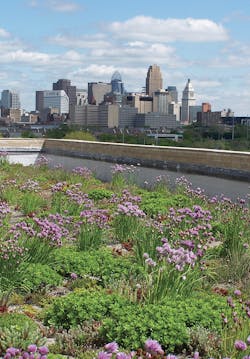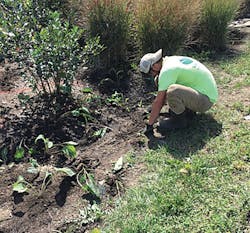Cincinnati's major green infrastructure program aims to manage 11 billion gallons of annual CSOs.
One of the more high-profile features of MSDGC's Project Groundwork is the bioswale inside Rapid Run Park, located on a major thoroughfare of the city.
Cincinnati, Ohio, is a large city with a small community feel in many of its neighborhoods. Located between the Little Miami and Great Miami Rivers on the north shore of the Ohio River, Cincinnati lies in Hamilton County. Residents lovingly call their city the "City of Seven Hills" due to the slopes and inclines — including seven major hills that form a crescent from the east and west banks of the Ohio River — that characterize the area.
The Metropolitan Sewer District of Greater Cincinnati (MSDGC) manages the collection and treatment of about 180 million gallons of wastewater daily, maintains 3,000 miles of sanitary and combined sewers and is among the top 5 combined sewer overflow (CSO) dischargers in the country. Early in 2002 and 2004, MSDGC was placed under two federal consent decrees that sought to address major CSO and sanitary sewer overflow events, and a Wet Weather Improvement Plan (later dubbed Project Groundwork) was approved in 2010. The U.S. Environmental Protection Agency specifically tasked MSDGC with reducing CSOs in the Mill Creek Watershed, an urban creek that flows from the north to south ends of the city and is a tributary of the Ohio River. The watershed contributes more than half of the billions of gallons of sewage and stormwater that overflow annually from combined sewers across Hamilton County.
"A special focus of our Wet Weather Improvement Plan was the Mill Creek Watershed area, and EPA's default solution was an underground storage tunnel with a high-rate treatment facility," Deb Leonard, communications manager for MSDGC, said. "MSDGC actually lobbied EPA to look at a green infrastructure-based alternative."
For three years, MSDGC studied green infrastructure to determine whether the agency could successfully implement a program while simultaneously exploring and planning for the tunnel. During this period, MSDGC partnered with more than 20 different local organizations on low impact development (LID) projects (characterized by the containment of less than 10 million gallons annually). Partner projects included installation of pervious pavers on Cincinnati Department of Transportation and Cincinnati Public School properties; green roofs at the Cincinnati Museum Center and some Cincinnati Public Parks buildings; bioswales, rain gardens and bio-infiltration basins at Cincinnati State Technical College; and enhanced turf and rainwater harvesting programs at the Cincinnati Zoo, among others.
"MSDGC monitored these projects from the beginning and realized that these LID solutions, while great for our partners, would not give us the results we wanted. We needed to go with some larger scale stuff to really manage [our issues]," Leonard said.
The Revised Original Lower Mill Creek Partial Remedy (LMCPR) was born. This green solution was not only equal to the tunnel in terms of reduction of the amount of CSOs but significantly cheaper, saving the city $200 million over the life of the project. In 2013, EPA approved MSDGC's plan.
"We were pretty used to just putting a sewer in the ground and operating or maintaining it through our wastewater collections division," Leonard added, noting that the District needed to come up with a new plan for managing and maintaining these new projects. "We added an Office of Watershed Management to our team as we started to put in larger-scale green infrastructure," she said.
The learning curve was steep.
One of the first green infrastructure projects — a bioswale in Cincinnati's Rapid Run Park — had a lot of plants die, and the landscaping had to be replanted several times. Also, a park pond was plumbed into the bioswale, which resulted in drainage issues in the bioswale.
"With every storm we get, the infrastructure changes," said Leslie Schehl, supervising engineer with MSDGC's Watershed Operations division, the department that manages all of MSDGC's wet weather assets, from green infrastructure to high-rate treatment facilities or enhanced treatment facilities, and smart sewer.
"After major wet weather events, sediment accumulates in our bioretention basins and needs to be scraped off by our maintenance crews. We've had to remove approximately 100 pounds of sediment from the top of just one of our bio-infiltration basins [after heavy rainfall]," Schehl said.
Regular monitoring of MSDGC's wet weather assets occurs once a month, along with seasonal inspections to assess conditions and maintenance issues. It's something that Schehl says is important for any utility looking to add to its stormwater management program.
One of MSDGC's early projects included a green roof installed at the Cincinnati Museum Center.
"Having a maintenance plan in place before building assets is the most important part of this process because it is really easy to get behind and end up somewhere you don't want to be," she said.
MSDGC's Lick Run Project, which is the largest project in the LMCPR, is also the largest green infrastructure undertaking in the district's history.
The nationally-recognized project will reduce overflows into the Mill Creek Watershed by about 369 million gallons annually, during a typical year of rain (41 inches). The project, comprised of various green infrastructure and new storm sewers under roadways, will convey stormwater and natural drainage through the watershed to a one-mile-long bio-engineered stream in the middle of a residential park known as the Lick Run Greenway and the Mill Creek.
Maintenance of green infrastructure assets in Cincinnati is conducted monthly to
ensure that bioretention basins and bioswales are operating correctly.
In addition to these projects, MSDGC is also restoring streams in ravines that were previously enclosed in combined sewers. "Cincinnati is a very hilly city — we have a lot of drainageways and ephemeral streams that would only flow during and after a rainstorm," Leonard said. "[In these areas] inlets were previously placed along the streambed or the drainageway bed, forcing the water into a combined sewer that ran beneath it, effectively killing the stream and overflowing the sewers."
Leonard said MSDGC has begun closing off the stormwater inlets to restore streambeds, adding in stormwater retention basins to slow the flow.
The Lick Run Project will remove about 500 million gallons of stormwater from MSDGC's combined sewer system by the end of 2018. The primary feature is a mile-long engineered stream that will mimic a natural creek, fed by diverted stormwater from nearby green infrastructure projects.
Bridging the Skills Gap
Early on, Schehl said MSDGC noticed a skills gap in the workforce for green infrastructure maintenance.
"The contractors we were using weren't familiar with green infrastructure and how it was supposed to function, and that it was different than just an average landscaped area," she said. "We started exploring a certificate program for green infrastructure maintenance on a regional level, but quickly realized how much time and money that would take.
About the same time, the Water Environment Federation and DC Water approached MSDGC to become a partner in a national certification program for green infrastructure construction, inspection, and maintenance. The National Green Infrastructure Certification Program (NGICP) establishes national standards for working on green infrastructure projects, and includes a training and certification program.
DC Water's training cohort from June 2017 learns about green infrastructure design
and maintenance. (Photo courtesy DC Water)
MSDGC was one of 16 partner utilities during NGICP's pilot program in 2016, when 35 participants took an MSDGC-sponsored training course. All 35 participants passed the final exam, and Schehl says she is looking forward to hosting another class of trainees in the fall.
To date, more than 200 people have been certified for green infrastructure jobs through the NGICP across the U.S. A big part of the impetus to establish the program, according to Tim Williams, deputy executive director for WEF, is to target and train employees who are experts in green infrastructure solutions.
"Water utilities are facing big expenses when it comes to these issues of addressing water quality and runoff," Williams said. "Because of the nature of green infrastructure and because it involves natural systems, there is a need to test and publish best practices, design and standards … so that communities will know that they will achieve desired results. A big part of that is having personnel who are trained to inspect, install and maintain green infrastructure, so that is where NGICP comes in."
Williams noted that the benefits for water quality are there, but so are the benefits for jobs and the water sector workforce. "This program is specifically designed to target folks in each community who would be able to be trained and employed as green infrastructure workers," he explained, "and people with these certifications will be [able to get the] increasing number of jobs in the green infrastructure space."
The training/certification program includes 35 classroom hours, followed by a comprehensive exam. Participants who pass the exam must maintain a minimum level of on-the-job hours to continue to receive certification.
"Workforce development, jobs training and jobs skills are all areas where utilities and cities have partnered in the past," Williams said. He also noted the interest from parks departments across the country who have green infrastructure installed but need the maintenance work to be done professionally. "As the practice becomes more mainstream, I think we will continue to see interest in the NGICP."
Green infrastructure is a growing and dynamic area for the water sector, Williams added, "so I think we will see even more interest in these programs in the future."
About the Author

Alanna Maya
Chief Editor
Alanna Maya is a San Diego State University graduate with more than 15 years of experience writing and editing for national publications. She was Chief Editor for WaterWorld magazine, overseeing editorial, web and video content for the flagship publication of Endeavor's Water Group. In addition, she was responsible for Stormwater magazine and the StormCon conference.





